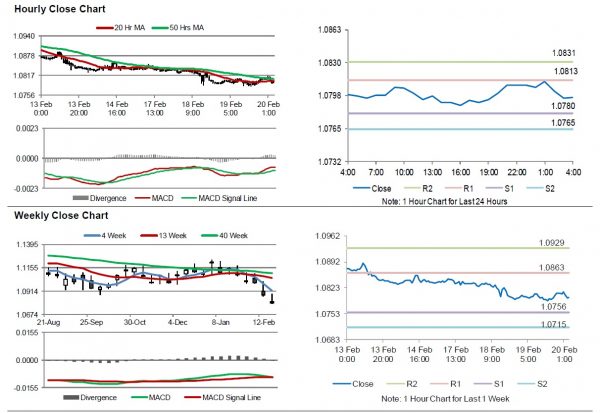For the 24 hours to 23:00 GMT, the EUR rose 0.13% against the USD and closed at 1.0808.
Data showed that Euro-zone’s seasonally adjusted current account surplus widened to €32.6 billion in December, undershooting market expectations for a surplus of €36.4 billion and compared to a revised surplus of €32.4 billion in the previous month. Additionally, construction output fell 3.1% on a monthly basis in December, amid decrease in building construction and compared to a revised advance of 0.7% in the prior month.
In the US, data showed that the producer price index (PPI) climbed 2.1% on an annual basis in January, surpassing market anticipations for a rise of 1.6%. In the previous month, the PPI had risen 1.3%. Additionally, building permits advanced 9.2% on a monthly basis to an annual rate of 1551.0K in January, hitting its highest level since March 2007 and compared to a revised level of 1420.0K in the previous month. Meanwhile, housing starts dropped 3.6% on a monthly basis to an annual rate of 1567.00K in January, compared to a revised level of 1626.00K in the prior month. Moreover, the MBA mortgage applications declined 6.4% on a weekly basis in the week ended 14 February 2020, compared to rise of 1.1% in the previous week.
Separately, the Federal Open Market Committee (FOMC), in its January meeting minutes, indicated that interest rates are expected to remain unchanged for some time and economic growth is expected to continue at a ‘moderate pace’. Meanwhile, the minutes reiterated that though trade uncertainties had diminished following the signing of the phase one US-China trade deal, downside risks posed by the outbreak of the coronavirus ‘warranted close watching’.
In the Asian session, at GMT0400, the pair is trading at 1.0796, with the EUR trading 0.11% lower against the USD from yesterday’s close.
The pair is expected to find support at 1.0780, and a fall through could take it to the next support level of 1.0765. The pair is expected to find its first resistance at 1.0813, and a rise through could take it to the next resistance level of 1.0831.
Looking ahead, traders would keep a close watch on Euro-zone’s consumer confidence index for February along with Germany’s producer price index for January and the GfK consumer confidence index for March, slated to release in a few hours. Moreover, the US initial jobless claims followed by the Philadelphia Fed manufacturing survey for February, scheduled to release later in the day, will keep investors on their toes.
The currency pair is showing convergence with its 20 Hr moving average and trading below its 50 Hr moving average.















